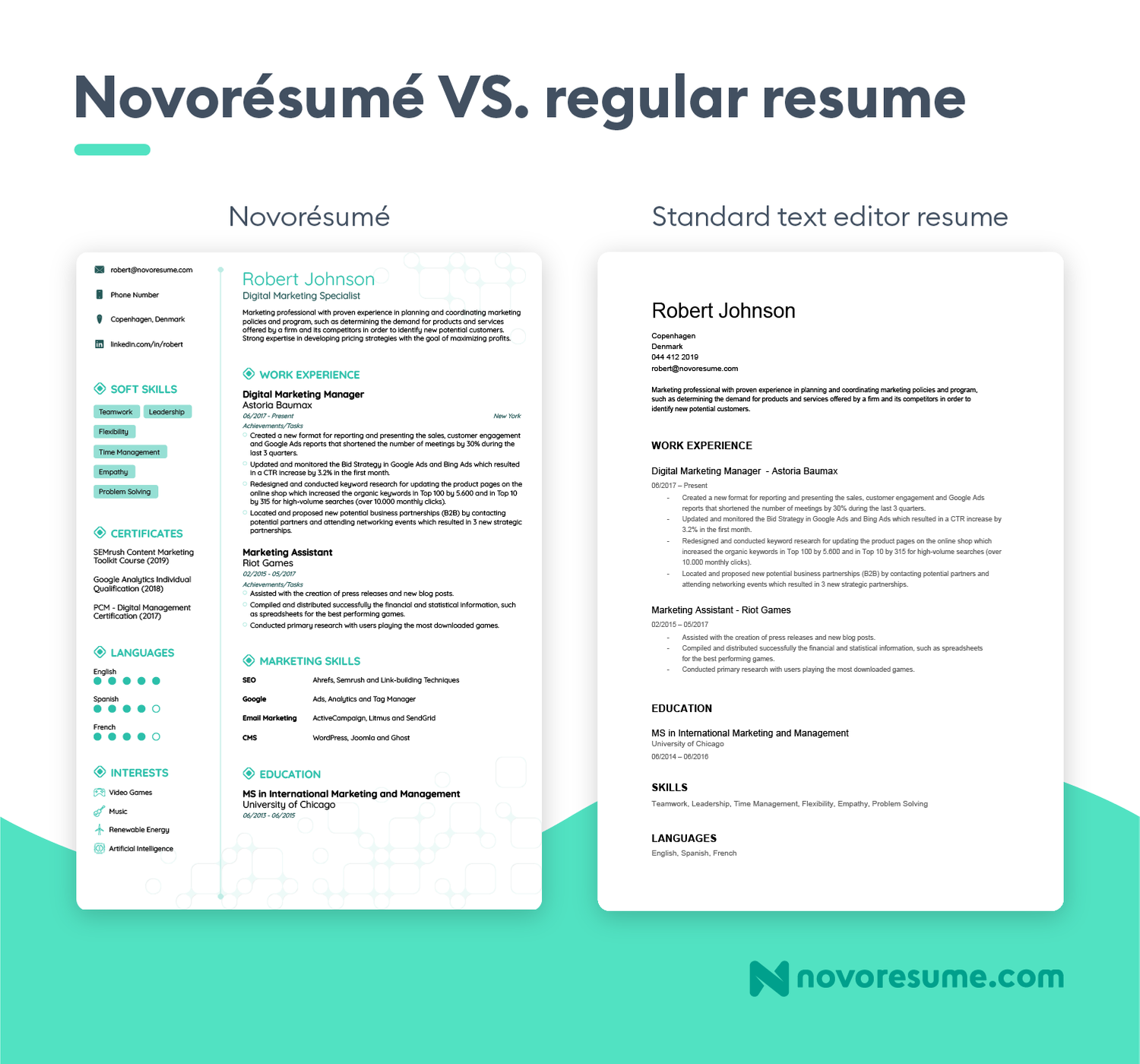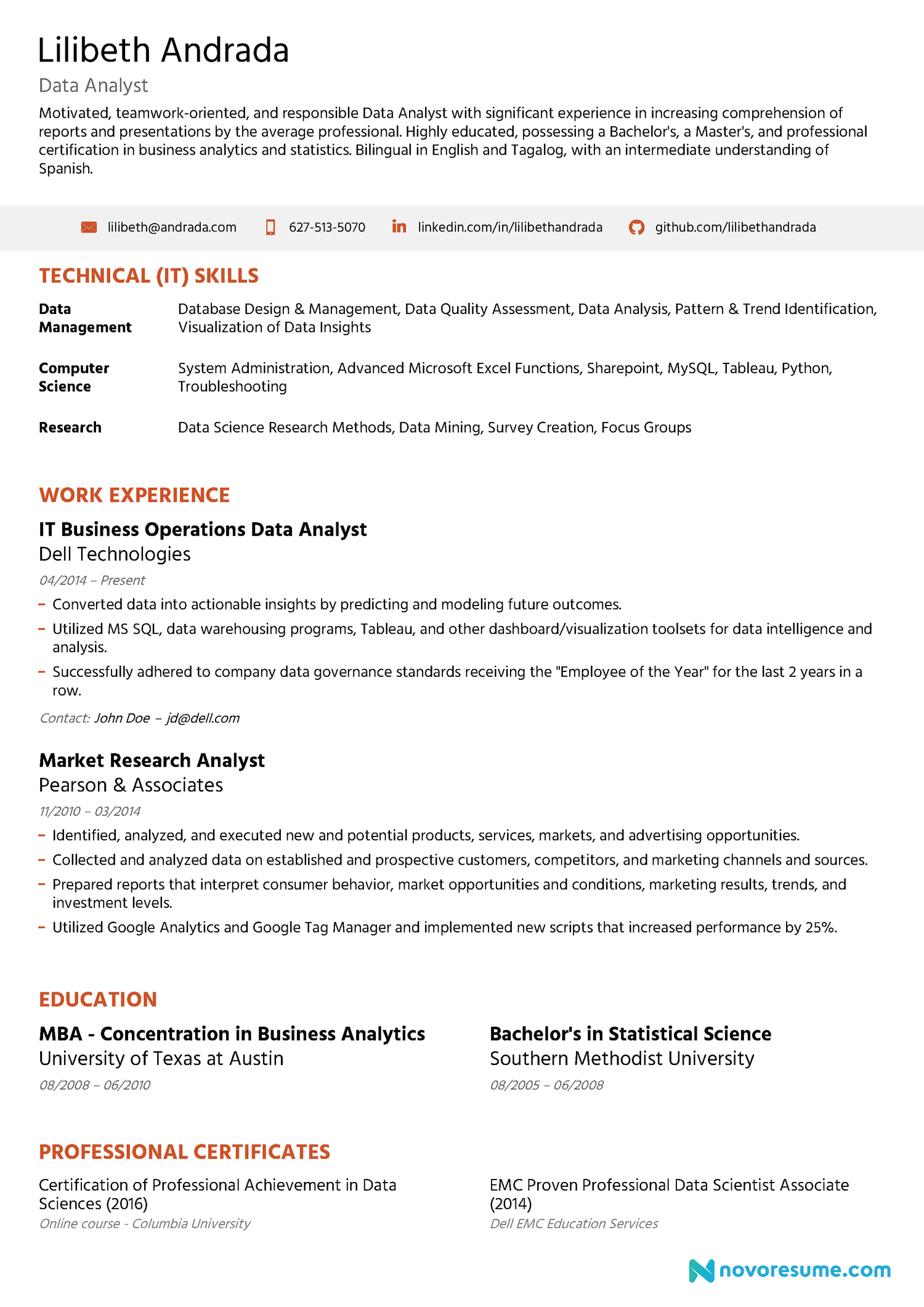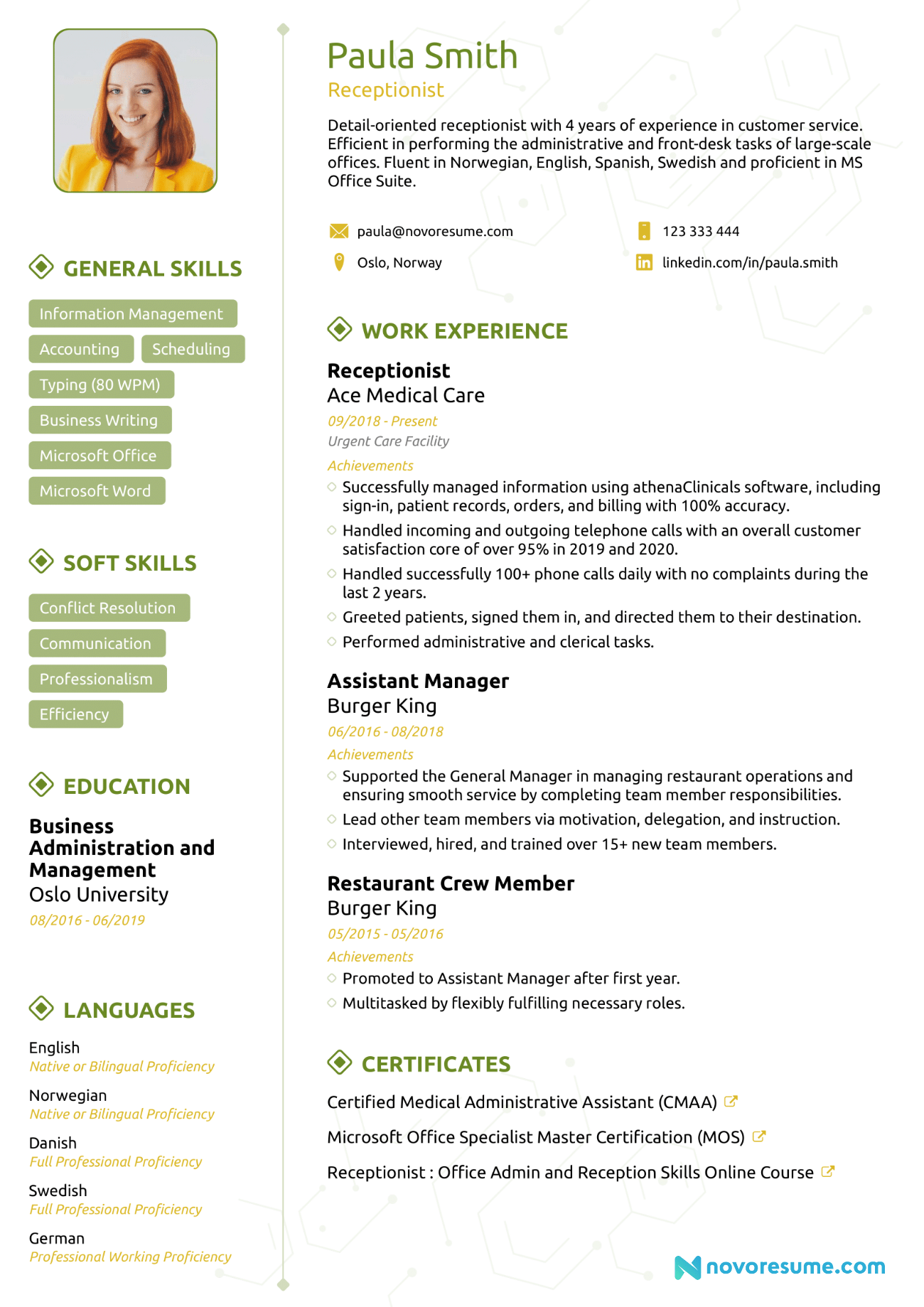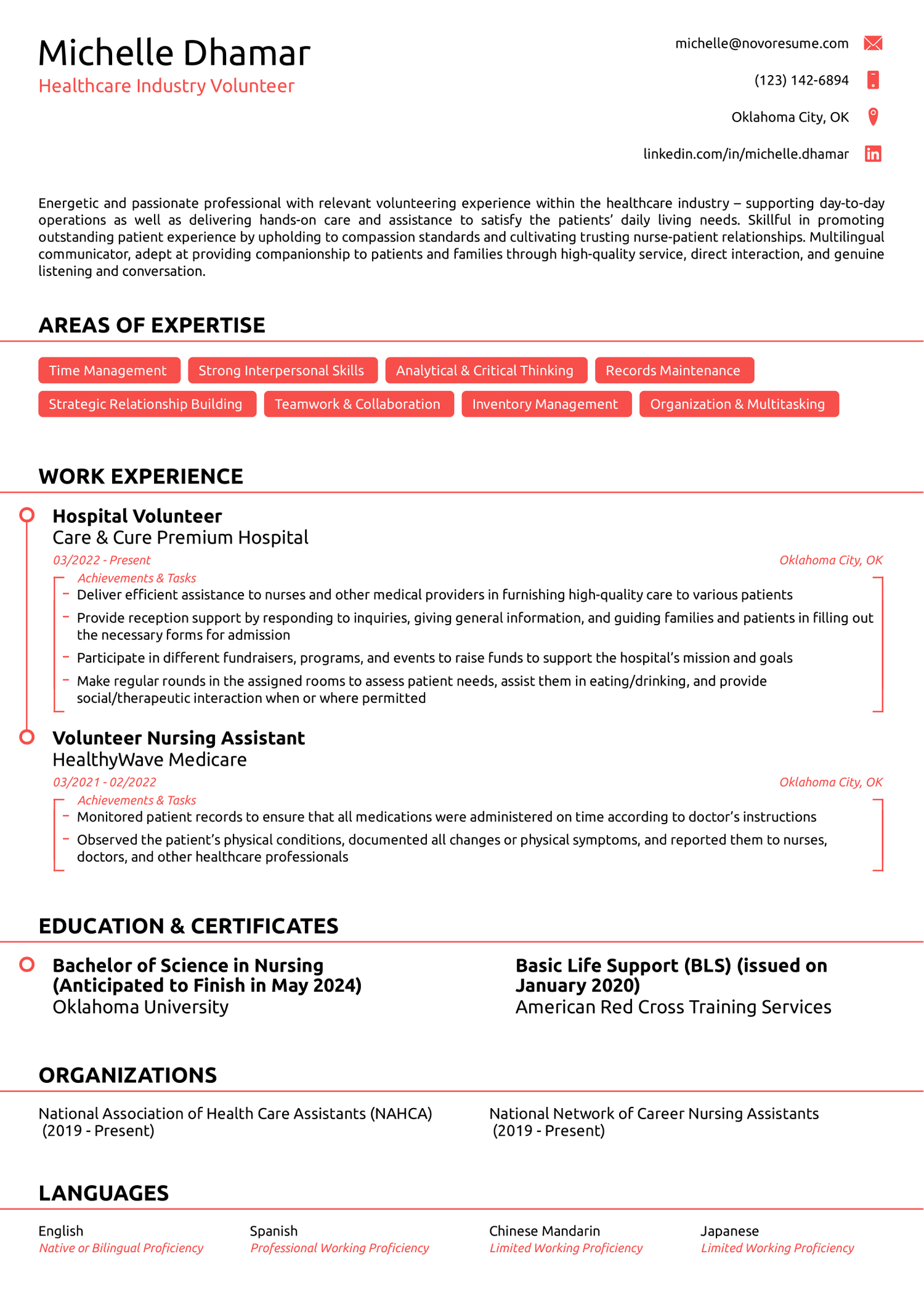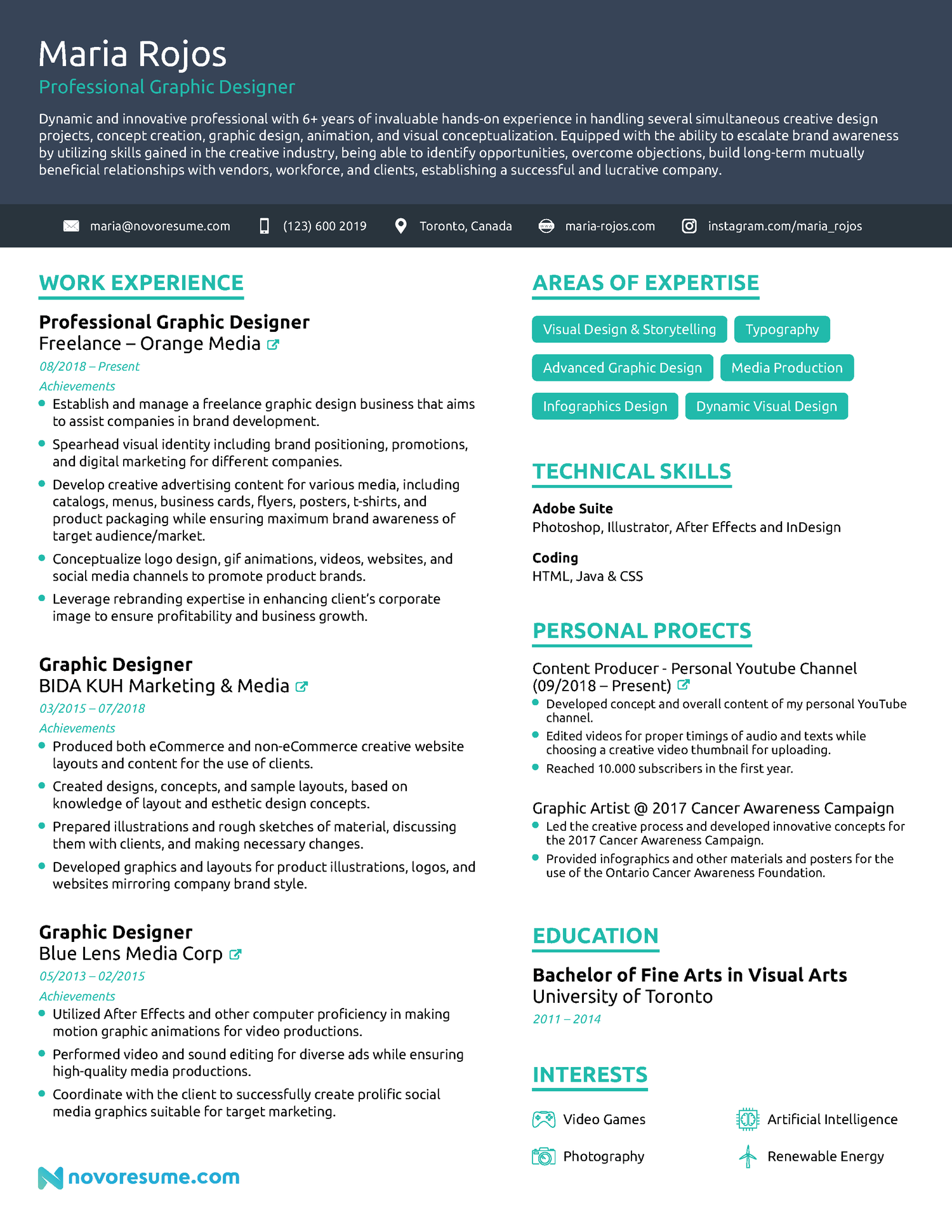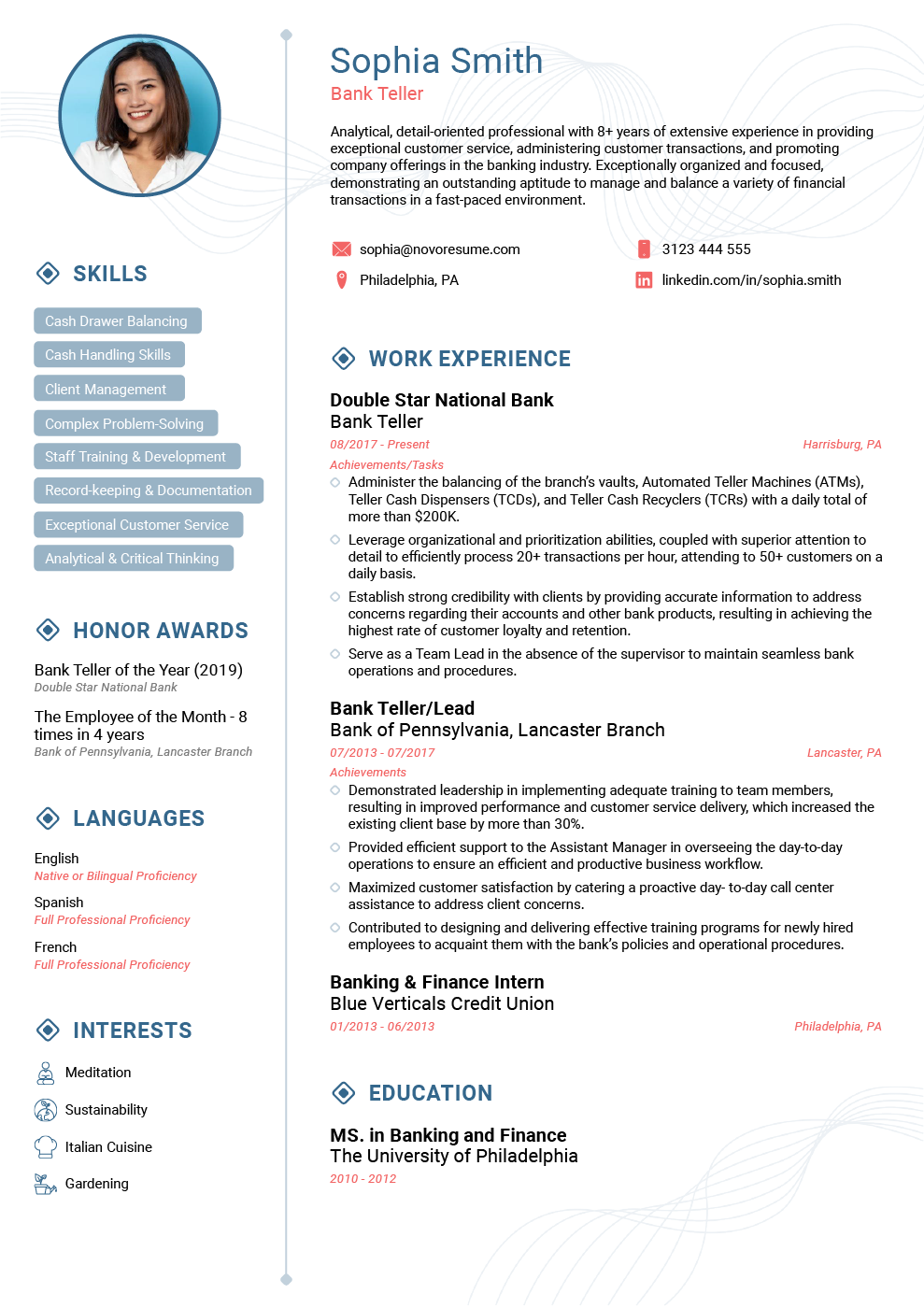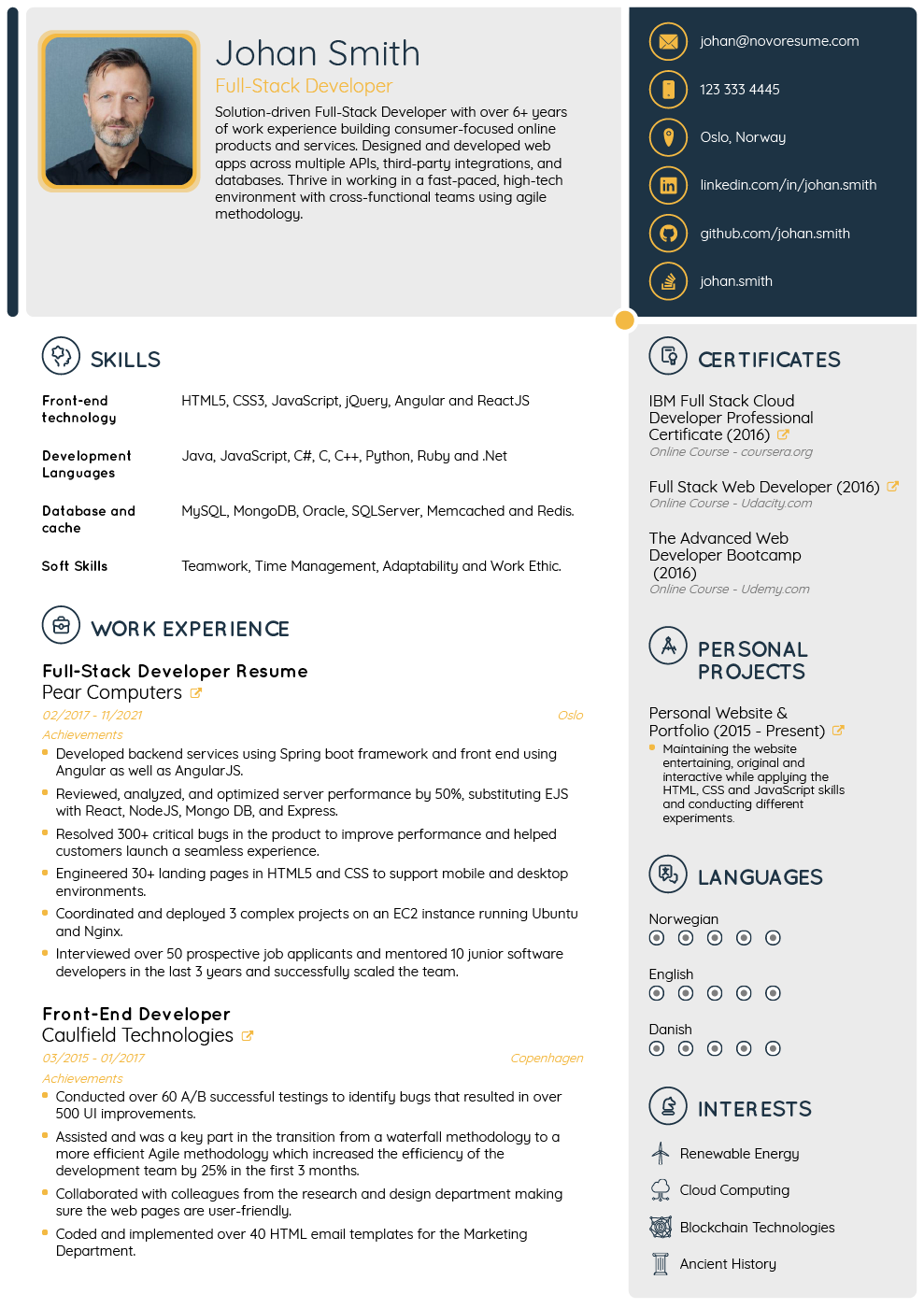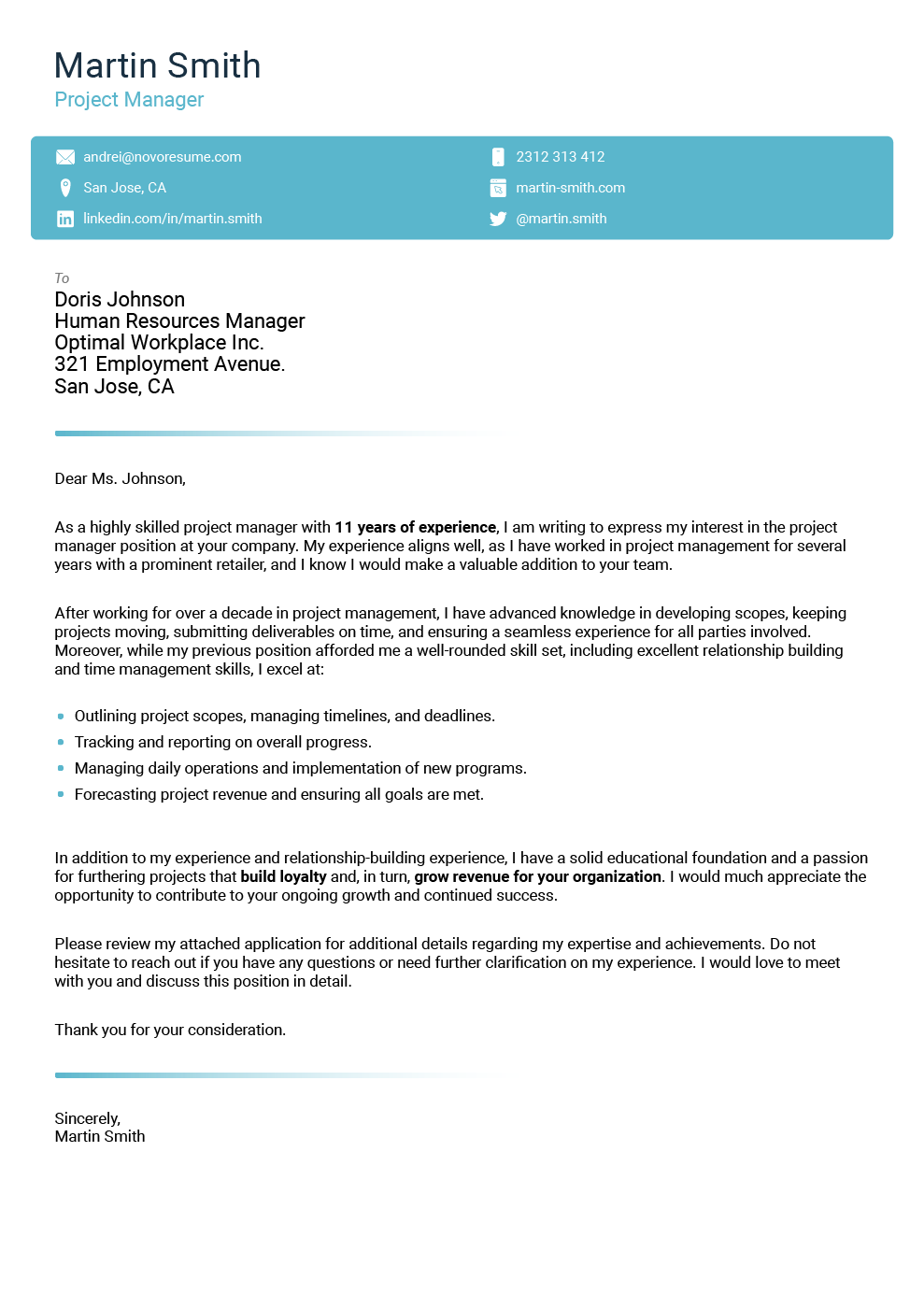For most job-seekers, a good resume is what stands between a dream job and Choice D. Get your resume right, and you’ll be getting replies from every other company you apply to.
If your resume game is weak, though, you’ll end up sitting around for weeks, maybe even months, before you even get a single response.
So you’re probably wondering how you can write a resume that leads to HR managers inviting you to interviews daily.
Well, you’ve come to the right place!
In this guide, we’re going to teach you everything you need to know about how to make a resume, including:
- Pick the Right Resume Format & Layout
- Mention Your Personal Details & Contact Information
- Use a Resume Summary or Objective
- List Your Work Experience & Achievements
- Mention Your Top Soft & Hard Skills
- Include Additional Resume Sections (Languages, Hobbies, etc.)
- Tailor Your Information For the Job Ad
- Craft a Convincing Cover Letter
- Proofread Your Resume and Cover Letter
So, let’s dive right in!
New to resume-making? Give our resumes 101 video a watch before diving into the article!
How to Make a Resume (The Right Way!)
Before we go into detail about how you should make a resume, here’s a summary of the most important steps and tips to keep in mind:

- Choose a resume format carefully. In 99% of the cases, we recommend the chronological format.
- Add the right contact details. Leave your headshot out and make sure to include your job title, a professional email address, and relevant links (e.g. your LinkedIn profile, online portfolio, website, etc.).
- Write an impactful resume summary. Unless you’re an entry-level professional, always go for a resume summary (also known as a career summary). Done right, it’s your chance to get hiring managers to go through the rest of your resume in detail.
- Pay attention to your work experience section. Take your work experience section from OK-ish to exceptional by tailoring it to the job ad, making your achievements quantifiable, and using action verbs and power words.
- Add the right skills for the job. Keep this important section relevant by only including soft and hard skills that are required for the position. Deeper into the article, we’ll show you just how to do that!
- Keep your education short and to the point. Your most recent and highest degree is more than enough for a strong education section. We recommend making a more detailed education section only if you’re a recent graduate with barely any work experience.
- Take advantage of optional resume sections. Optional sections like languages, hobbies, certifications, independent projects, and the sorts, can be what sets you apart from other candidates with similar skills and experience.
- Don’t forget about the cover letter. Cover letters do matter in 2024 so you should definitely include one. To make the most out of your cover letter, check out this detailed guide on how to write a cover letter.
To get the most out of our tips, you can head over to the resume builder and start building your resume on the go as you read this guide.
#1. Pick the Right Resume Format
Before you start filling in your resume, you’ve got to make sure it will look good.
After all, recruiters first notice how your resume looks, rather than what it contains. So, this is your best chance to make a great first impression.
This includes picking the right resume format and doing the layout.
So, first things first - how should you format your resume?
There are three types of resume formats out there:
- Reverse chronological resume format. This is the most popular resume format among recruiters and, as such, the right format for most job-seekers.
- Functional resume format. This format focuses more on skills rather than work experience and is useful if you’re just getting started with your career and have little-to-no experience in the field.
- Combination resume format. The combination resume is a great choice for experienced job-seekers with a very diverse skill set. It’s useful if you’re applying for a role that requires expertise in 3-4 different fields and you want to show all that in your resume. Say, for example, you’re applying for a senior management role, and the requirements are expertise in Management, Sales, and Software Development.
So, which one do you go for?
As we already mentioned, in 99% of cases, you’d want to stick to the reverse-chronological resume format. It’s the most popular format, and most HR managers are used to it. Hence, in this guide, we’re going to focus on teaching you how to make a reverse-chronological resume.

Fix Your Resume Layout
With formatting out of the way, let’s discuss your resume’s layout. After all, the layout is the first thing a job recruiter notices about your resume.
Does it look organized or cluttered? Is it too short or too long? Is it boring and easy to ignore, or is it reader-friendly and attention-grabbing?
Here are some of the best practices when it comes to your resume layout:
- One page in length. You should only go for 2 pages if you really, really believe that it’ll add significant value. HR managers in big firms get around 1,000+ resumes per month. They’re not going to spend their valuable time reading your life story!
- Clear section headings. Pick a heading (H2, for example) and use it for all the section headers.
- Ample white space, especially around the margins. Without the right amount of white space, your resume will end up looking overcrowded with information
- Easy-to-read font. We’d recommend sticking to what stands out, but not too much. Do: Ubuntu, Roboto, Overpass, etc. Don’t (ever): Comic Sans
- Readable font size. As a rule of thumb, go for 11-12 pt for normal text and 14-16 pt for section titles.
- PDF file type. Always save your resume as a PDF file. Although Word is a popular alternative, it has a good chance of messing up your resume formatting.
One more thing you need to consider in terms of resume layout is whether you’re going for a traditional-looking resume template or something a bit more modern:

If you’re pursuing a career in a more traditional industry - legal, banking, finance, etc. - you might want to stick to the first.
If you’re applying to a tech company, though, where imagination and innovation are valued, you can go for a more creative template.
Want to Save Time? Use a (Free) Resume Template
Anyone who’s ever tried creating a resume from scratch knows how boring the formatting can be.
Before you can even start filling in the contents, you need to tweak the margins, adjust font sizes, make sure everything fits into one page WHILE also looking good, and so on.
Want to skip past that AND create a very compelling resume?
Try one of our free resume templates. They’re pre-formatted, so all you have to do is fill in the contents.
They’re also created in collaboration with recruiters from around the globe, ensuring that the templates are visually appealing and ATS-friendly!
See for yourself how it compares to a resume created in a text editor:
#2. Add Your Contact Information
Now that we’ve got all the formatting out of the way, let’s talk about what’s really important: your resume content.
The first thing you want to do when filling out the contents of your resume is to add your contact information.
This is a straightforward, yet critical section.
Even if you get everything else right, you’re not going to go far if the HR manager can’t get in touch with you because you misspelled your email, right?
So, double-check, and even triple-check your contact information section and make sure everything is correct and up-to-date.
Must-have Information
- First Name / Last Name.
- Phone Number.
- Email Address.
- Location - are you located in the area, or will the company have to sponsor relocation?
Optional Information
- Profesional Title - Your professional title. It can be your position, word-for-word, or your desired job. Think “Digital Marketing Specialist” or “Junior Data Scientist.”
- LinkedIn URL - If you have an up-to-date profile that can add value to your application, make sure to include the link.
- Relevant Social Media - Do you have a published portfolio online? For developers, this would be your GitHub, for a designer Behance or Dribble. For a writer, it could be your personal blog.
- Website / Blog - Do you have an online presence? Maybe a blog that positions you as an expert in your field? If you do, make sure to mention it!
- Date of Birth (unless specifically required in the job ad) - The HR manager doesn’t need to know how old you are. It’s not important for their decision-making, and at worst, it might lead to discrimination based on age.
- Unprofessional Email Address - Do: name.lastname@gmail.com Don’t: player69@gmail.com
- Headshot in USA, UK or Ireland. Consider including one in Europe & Asia, but always check the regulations for each specific country or industry.
All clear? Good! Now, let’s examine what a successful example of the contact section looks like:

#3. Write a Resume Headline (Summary or Objective)
It's no secret that recruiters spend less than ten seconds on a resume on average.
When you receive hundreds, if not thousands, of applications daily, it's physically impossible to spend too much time on each.
So, in order for the hiring manager to go through the resumes effectively (without spending an entire day), they scan through the resume real quick, and if it catches their interest, they get into it in more detail.
And the first thing that the hiring manager looks at is the resume headline.
Depending on your professional standing, a resume headline can be either a resume summary or a resume objective.
Both are placed at the top of your resume, right below or next to the contact information section. For example:

Now, you might be wondering whether you should use a resume summary or an objective, and how to write one effectively.
Well, that brings us to our next section:
What’s a Resume Summary & When to Use it
A resume summary is a 2-3 sentence summary of your career. You should use a resume summary in basically any situation, unless you’re a recent university graduate or switching careers (in that case, you use a resume objective. More on that later!).
In your resume summary, you need to mention:
- Your job and years of experience. E.g.: Customer support representative with 5+ years of experience in the IT industry.
- 1 or 2 top achievements (or core responsibilities). E.g.: Specialized in technical support, customer care, and user retention.
- Desired goal (generally, passion for working at a specific company). E.g.: Looking for new opportunities as a support lead for a SaaS company.
Here’s an example of a well-written resume summary:

What’s a Resume Objective & When to Use it
A resume objective is, in a nutshell, the goal of your resume. It communicates your motivation for getting into a new field. As with a resume summary, a resume objective should be around 2-3 sentences.
As we’ve mentioned before, a resume objective is the go-to for anyone who either has no work experience or is going through a career change.
So, here’s what that would look like if you’re a student:
- Hard-working recent graduate with a B.A. in Graphic Design from New York State University seeking new opportunities. 3+ years of practical experience working with Adobe Illustrator and Photoshop, creating illustrations & designing UX / UI. Looking to grow as a designer, as well as perfect my art, at the XYZ Design Studio.
Or, on the other hand, if you’re going through a career change:
- IT project manager with 5+ years of experience in software development. Managed a team of developers to create products for several industries, such as FinTech and HR tech. Looking to leverage my experience in managing outsourced products as a Product Owner at XYZ.
#4. Prioritize Your Work Experience
The most important part of your resume is your work experience.
This is where you really get to sell yourself, displaying your past accomplishments and responsibilities.
If you manage to master this section alone, you’ll know 80%+ of all there is to know about how to make a resume.
There are plenty of best practices for writing your work experience. Before we dive into all the nits and grits, though, let’s start with the basics...
How to List Work Experience in a Resume
The standard format for your work experience is as follows:
- Job Title/Position - Your job title goes on top of each work experience entry. When the HR manager scans your resume, you want them to know, at a glance, that you have relevant work experience for the job.
- Company Name / Location / Description - Then, you mention the name of the relevant employer, as well as the location of the office you work/have worked in. In some cases, you may also want to briefly describe the company, if the organization is not a famous household name.
- Dates Employed - The timeframe of your employment in each company. Not sure about the exact dates you worked somewhere? Don’t worry - you don’t have to be accurate by the day, as long as it’s close. The standard format expected by recruiters and employers is mm/yyyy (this is especially important when your job application will be parsed by an Applicant Tracking System).
- Achievements and Responsibilities - This is the core of each work experience entry. Depending on your field, you want to list either your achievements or responsibilities. We’ll get more into the hows and whys of this in a bit.
Here’s a real-life example:

As you can see, the work experience listings should be mentioned in reverse-chronological order - starting with the most recent job and going all the way back into the past.
Now that you know how to list your experience, we’re going to talk about how to write about your experience in such a way that you stand out from the competition.
Are you a student with no work experience? We’ve got you covered. Check out our guide to writing a resume with no experience here.
List Achievements When Possible
One of the most common resume mistakes is listing only responsibilities in your work experience section.
Here’s the thing - in most cases, the hiring manager knows exactly what your responsibilities were. Let’s say you’re a sales manager, for example. Your responsibilities would be:
- Reach out to potential clients over the phone or email.
- Maintain relationships with existing company clients and upsell relevant products.
- Tracking and reporting on leads in CRM.
- Coincidently, this is exactly the same list of responsibilities for every sales manager. 90% of all other resumes probably mention just about the same thing.
So, to stand out, you want to focus on mentioning achievements in your resume instead. Or in simple terms, how exactly you helped the company grow, reach quarterly quotas, and so on.
- Exceeded sales team KPIs by 30%+ for 3 months straight.
- Generated over $24,000 in sales in 1 month.
- Generated leads through cold-calling
- Managed existing company clients
Keep in mind, though, that in some fields, there aren’t that many achievements you can mention. Let’s say you work in a warehouse. Your day-to-day responsibilities probably involve:
- Loading, unloading and setting up equipment on a daily basis.
- Package finished product and get it ready for shipping.
- Assist in opening and closing the warehouse.
In such fields, it’s pretty hard to distinguish yourself, so it’s totally OK to stick to responsibilities instead.
Tailor Your Resume to the Job
Tailoring is what sets an amazing resume apart from the “OK” one.
Hiring managers don’t want to know every single job you’ve worked, or every single skill that you possess.
They specifically want to know about your jobs, experiences, or skills that are somehow related to the role you’re applying for.
For example, if you’re applying for a job doing Google Ads, you don’t really need to talk about your SEO internship from 8 years ago.
By focusing your resume on whatever is important for a given role, you’re a LOT more likely to stand out and catch the hiring manager’s attention!
So, let’s cover a simple example of how to do this. Let’s say that after reading the following job ad for the position of a digital marketer, you discover that the most critical requirements for the job are:
- 5+ years of experience in online marketing
- Social media marketing experience, with good knowledge of Facebook advertising
- B.A. in Marketing or Business Administration
- Experience managing a 20,000 USD monthly advertising budget on Facebook

Now, to tailor your resume to these requirements, simply mention each in your resume, as long as you have the relevant achievements and qualifications!
For example, you can use:
- Your resume summary to mention your years of experience,
- Your achievements in previous jobs to prove you’ve got social media marketing experience
- Your education section to let the hiring manager know you have the degree they’re looking for
Include the Right Amount of Work Experience
If you’ve got over a decade’s worth of work experience, you’re probably confused about how much of it you mention in your resume. After all, If you had to list everything you’ve ever done, you’d end up writing a mini-novella.
Or, on the other hand, if you’re a newcomer to the job market, you probably don’t have any experience and are wondering what you could even mention.
Here’s how much information you’d mention in your resume depending on your level of experience:
- Job hunters with no experience - If you don’t have any experience, it might be a bit hard to fill in your work experience section. You can either keep it empty and focus on all the other sections, or fill it up with work experience in student organizations, non-profits, etc.
- Entry-level candidates - List all the work you’ve done up to today. While some of it won’t be relevant, it will still show the hiring manager that you do have practical work experience.
- Mid-level professionals - ONLY mention work experience relevant to the position you’re applying for.
- Senior professionals - List up to 15 years of relevant work experience MAX. If your recent experience is as a CEO, no one cares about how you started your career as a junior marketing specialist.
Consider Applicant Tracking System (ATS) Software
Did you know that over 70% of resumes don’t even make it to the hiring manager?
Most companies these days use applicant tracking software to evaluate hundreds of resumes instantaneously and filter out the ones that don’t fit certain criteria. For example, if the resume doesn’t mention a specific skill, or if the resume is not formatted the right way.

Fortunately, there are some easy ways to make your resume ATS-friendly:
- Check the job description for resume keywords. Tailoring your resume to the job also helps a lot with beating the ATS software. So, scan the job description carefully for hints and, whenever you find keywords related to your responsibilities and achievements, make sure to include them in your work experience section.
- Don’t make your resume longer than two pages. Sometimes, for whatever reason, employers set a limit on how long a resume should be. Meaning, if your resume is longer than one page, it might get automatically disqualified.
- Always use an active voice when describing your achievements. Passive voice is vague and unclear. Make sure to use active voice as much as possible when adding bullet points under your job entries (e.g. “managed a team of ten people” instead of “a team of ten people was managed by me”).
- Take advantage of action verbs and power words. Instead of starting each of your sentences with “was responsible for,” make your work experience impactful by taking advantage of words that can grab attention (e.g. spearheaded or facilitated).
Want to make sure your resume formatting passes the ATS test? Choose one of our ATS-friendly resume templates and you’ll be good to go!
#5. List Your Education
The next section we’re going to cover is your education. Let’s start with the basics - how to format the education section & what to mention there. Then, we’ll move on to tips & tricks that’ll help you stand out…
- Program Name. E.g.: “B.A. in Business Administration”
- University Name. E.g.: “New York State University”
- Years Attended. E.g.: “08/2008 - 06/2012”
- (Optional) GPA. E.g.: “3.9 GPA”
- (Optional) Honors. E.g.: Cum Laude, Magna Cum Laude, Summa Cum Laude.
- (Optional) Academic achievements. Any interesting papers you’ve written, courses you’ve excelled in, etc.
- (Optional) Minor. “Minor in Psychology”
Here's an example:

- If you don’t have any work experience, mention your education section first.
- Mention your latest educational entry on top.
- If you have a university degree, don’t mention your high school at all.
- ONLY mention GPA if you had a very impressive academic career (3.5 GPA plus).
#6. Emphasize Your Know-How with the Skills Section
Another must-have section in your resume is the skills section. Here, you want to mention all your know-how that makes you the perfect candidate for the job.
There are two types of skills you can include when writing your resume:
- Hard Skills (Measurable abilities). This can be anything from coding in Python to knowing how to cook Thai cuisine.
- Soft Skills (Personal skills). These are a mix of social skills, communication skills, personal traits, career attributes, and so on. Leadership, critical thinking, time management, and organization, just to name a few.
A good resume should cover both.
How to List Skills in Your Resume
Regarding how to list skills on your resume, there are three essential steps to follow:
Step #1 - List Hard Skills with Experience Levels. For each hard skill you list, you want to mention your proficiency level:
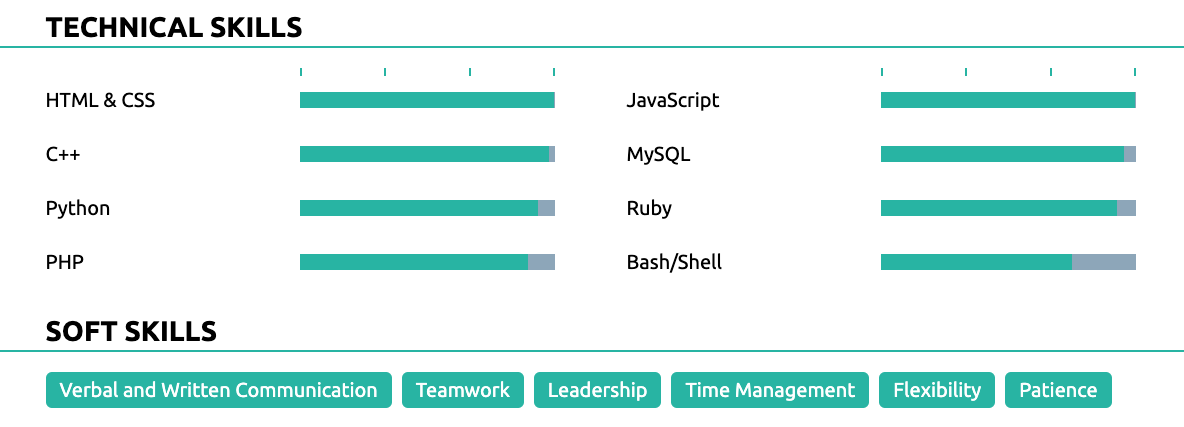
Here’s how you can categorize your hard skills:
- Beginner - You have some experience with the skill, whether it’s from some entry-level practice or classroom education.
- Intermediate - You’ve used the skill in a work environment with a good level of understanding.
- Advanced - You’re the go-to person for the skill in your office. You can coach other employees, and understand the skill on a high level.
- Expert - You’ve applied this skill in more than a handful of different projects & organizations. You’re the go-to person for advice about the skill, not just in your office, but even amongst some of the best professionals in your field.
Make sure to NEVER lie about your skill levels. Otherwise, it’s going to be pretty awkward both for you and your employer.
Step #2 - Tailor Your Skills to the Job. You might have some awesome skills, but probably not all of them will come handy for the job. For example, it’s awesome that you know how to cook, but would you really need it at your new job as an accountant? Exactly!
To tailor your skills to the job, take a look at the job ad and list 2-3 essential skills required for the job.
Qualifications:
- University Degree
- Tech-savvy, with some background in CMS systems such as WordPress
- Thrives in a stressful environment & manages to juggle multiple tasks and deadlines
- Organizational and time management skills
- Excellent communication skills
- Self-reliant, with the ability to manage their own work
- Can-do attitude and an outside-the-box thinker
Systems:
- Proficient in Photoshop, InDesign, Illustrator, Keynote and Pages
- Basic understanding of Office software - Word, Excel, Powerpoint, and Outlook
As you can see, the must-have skills here are Photoshop, InDesign, Illustrator, Keynote and Pages. A good-to-have is WordPress. You can also mention Word, Excel, Powerpoint, and Outlook, but it’s pretty much assumed that you know how to use them, as they’re required for most office jobs.
If you’re qualified, make sure to mention all relevant skills with respective proficiency levels in your “Hard Skills” section.
Step #3 - Include Some Transferable Skills. These are the type of skills that are useful for almost any job out there. They are both soft skills (leadership, teamwork, critical thinking, etc.) and hard skills (Excel, Powerpoint, Photoshop, writing, etc.). Whatever job you’re applying to, chances are, these skills will in one way or another come in handy, so feel free to include them, even if they’re not specifically required for the position.
Not sure which skills to mention for your field? It might be one of these 100+ essential skills to put on any resume!
#7. Include Other Important Resume Sections

The sections we’ve covered so far are must-haves for any resume. They’re the bread-and-butter for any job application, and if you get them right, you’ll land any job you apply to.
The following optional sections, though, can also give your resume a boost!
Languages
Are you bi-lingual? Or better, multi-lingual? You should ALWAYS mention that on your resume!
Even if the position doesn’t require you to know the specific language, it can still come in handy at some point. At the end of the day, it’s always better to know more languages than less.
To list languages in your resume, simply write them down and assign them the appropriate level:
- Native
- Fluent
- Proficient (Enough knowledge to pass by in a professional environment)
- Intermediate
- Basic
As a given, you should never lie about your language skills. You never know, your interviewer might turn out to be fluent in the language, or even be a native speaker!
Hobbies & Interests
Want to add some spice to your resume? The hobbies and interests section, while not a game-changer, can help show who YOU are as an individual. Who knows, maybe you and your interviewee have some hobbies in common!
If you end up with some extra space in your resume, don’t hesitate to show off your personality with a hobbies/interests section.
Volunteering Experience
If you’re the type of person who uses your free time helping others, while expecting nothing in return, chances are that you’re the type of employee who’s in it for more than just the money. It leaves the impression that you’re a devoted, loyal employee.
Several studies show that you can boost your chances of getting hired simply by listing your volunteering experience. This holds especially true if you’re a student with next to no work experience.
Certifications & Awards
Do you have any awards that make you stand out in your field? How about certifications from industry experts?
Whichever the case is, as long as it’s relevant for the position you’re applying for, feel free to add it to your resume.
Let’s say, for example, you’re a Microsoft Cloud Engineer. Assuming you specialize in Microsoft Technologies, you’d definitely want to include all essential certifications, such as the Azure Solutions Architect Expert one.
Publications
Are you a freelance writer? Maybe a distinguished academic?
If you have any published works (online, or in an academic journal), you might want to include them in your resume. Make sure to include a URL, so the HR manager knows where to check your work!
Projects
Working on side projects can really show off your passion for your field. Whether they’re university class projects or part-time entrepreneurial endeavors, they’re both equally relevant.
Let’s say, for example, you worked on a mock software product as part of a competition in university. You went through every step of product creation, from ideation to creating a marketing strategy.
You can mention the project in your resume and stand a better chance at landing that business internship!
Or on the other hand, maybe you manage an Etsy store, selling hand-made arts & crafts to customers online. Mention all of it!
Hiring managers love employees who do cool work in their free time.
Perfecting Your Resume - FREE Checklist
Already done with your resume? Interested in seeing how it holds up? Go through our checklist for perfecting your resume and see where you stand!

If you ☑’d all the points? Congrats! You’ve mastered all there is to know about how to write a resume, and you’re good-to-go to move on with your job search! If you missed some points, though, just go through your resume one more time and perfect it as much as possible.
Wondering how to write a CV instead of a resume? Check out our step-by-step guide on how to write a CV (31+ examples included)!
5+ Effective Resume Examples for Different Jobs
Knowing how to write a resume is one thing, actually creating a resume that stands out is something else entirely. Without inspiration, even top career experts might stumble on a roadblock or two.
Check out the following effective resume examples for different job positions to get a better sense of what a good resume looks like...
#1. Architect Resume Example
#2. Data Analyst Resume Example
#3. Web Developer Resume Example
#4. Remote Job Resume Example
#5. Sales Associate Resume Example
#6. Receptionist Resume Example
Want to see more examples? Check out our compilation of 80+ resume examples for different fields.
5+ Resume Templates for Different Industries
#1. Traditional Resume Template
Good for traditional industries like finance, banking, manufacturing, etc.
#2. Modern Resume Template
Good for both contemporary and forward-looking industries, including entrepreneurship, Medical Technology, engineering, etc.
#3. Creative Resume Template
Good for creative industries, including arts, design, architecture, and the sorts.
#4. Minimalistic Resume Template
Good for experienced professionals in basically any industry who want to let their achievements do the talking.
#5. IT Resume Template
Good for any IT-related profession.
#6. Tech Resume Template
Good for the tech industry and everything it encompasses.
Next Steps After Your Resume
Now that we’ve covered everything you need to know about how to create a resume, let’s talk about cover letters and interviews.
After all, your resume is only the first step in your job search. To really land that job you deserve, you also need to craft a killer cover letter, and ace that upcoming interview.
How to Write a Convincing Cover Letter
Every job application consists of 2 parts - the resume and the cover letter. Now that we’ve covered the first, let’s briefly explain the latter.
Most job-seekers flinch when they hear that they have to write a cover letter. What do you even mention in a cover letter, anyway? If you were good at writing cover letters, you’d be applying for a writing job!
In reality, though, writing a cover letter is pretty simple, if you know its purpose.
You should think of a cover letter as a direct message to the hiring manager. You get to briefly explain why you’re such an awesome fit for the position. When we put it that way, it doesn’t sound as hard, does it?
Here’s a format you could follow:
- Start by introducing yourself (and leave an impression) - As a start, give a brief run-down on your work experience and mention why you’re interested in working for the company you’re applying for. You can also mention 1-2 of your top professional achievements to leave a good first impression.
- Explain how you’d excel at the job - Identify the top three requirements in the job ad. Then, dedicate one paragraph to explaining how you fulfill each requirement. So for example, if the requirement is “Facebook Advertising Experience,” mention how you have done Facebook ads in the past and how you’ve excelled at it.
- Conclude by expressing gratitude - Thank the hiring manager for reading your cover letter and make a call to action. For example, “If you’d like to know more about my experience with Project XYZ, I’d love to chat!”
All clear? Just in case, you can also check out a real-life example below:
Does writing a cover letter still seem a bit complicated? Doesn't have to be. Our guides on cover letter tips and common cover letter mistakes will take your cover letter to the next level.
How to Ace Your Next Interview
You’ve perfected both your resume & cover letter. Now, it’s time for the next (and final) step - the dreaded job interview.
Whether you’re an extrovert or an introvert, you probably hate the interviewing process. After all, sitting there while someone’s prodding into your past experiences and judging the hell out of you isn’t the most fun experience.
Did you know, though, that most interviewers ask the same questions? Yep - all you have to do is learn how to answer some of the most common interview questions, and you’ll be an interview away from landing your dream job!
Want to learn more? Check out our complete guide to Job Interview Questions and Answers.
Frequently Asked Questions on How to Make a Resume
Do you still have some questions about making a resume? Check out the FAQ below!
1. What does a good resume look like in 2024?
For your resume to look good in 2024, make sure it’s organized and clean, and isn’t longer than one page. Furthermore, be sure to include information that adds value to your application - so, leave out the redundancies and focus on your work experience, skills that you can prove, and on listing as many achievements as possible.
If you’re using a template, choose based on your industry. Conservative industries require more traditional resume templates, but if you’re into arts, design, architecture, marketing, etc., you can go for a more creative resume template.
Last but not least - remote work is big in 2024, so if that’s what you’re seeking, then consider creating a remote job resume.
2. How do you make a resume in Word?
The best way to create a resume in Word is to use a pre-customized Microsoft Word template. To access them, you should:
- Open MS Word
- Click “file” from the menu bar
- Select new
- Type resume templates in the search bar
That said, Word resume templates are generic, hard to personalize, and overall not very standoffish. Want a template that looks good AND is extremely easy to make? Check out ours!
3. How do I write a resume for my first job?
If you’re writing your first resume for an entry-level position, the hiring manager won’t expect you to have any work experience. However, you can make up for your lack of experience with your skills and academic achievements.
For example, you can take advantage of extracurricular activities, internships, volunteering experience, and other such experiences.
As such, for your first job, you should include a resume objective to your resume, emphasize your education, and replace your work experience section with one of the following: internships, volunteering, independent projects, etc.
4. How to make a resume on Google Docs?
The easiest way to make a resume on Google Docs is to choose one of their templates and fill it in on the go. All you have to do is go to your Google Drive’s template gallery, choose your favorite template, fill in your information, and voila - your Google Docs resume is ready to go!
That said, Google Docs templates are not the most user-friendly choice. You don’t have much flexibility with the layout and formatting is not their strong point. You tweak a section to the slightest, and the whole thing gets messed up.
If you want an easier option, check out our resume builder!
5. What kind of resume do employers prefer?
Typically, employers prefer one-page-long resumes that follow the reverse chronological format.
Hiring managers receive hundreds of resumes every day, so they don't have the time to read 3-page resumes.
Meanwhile, the reverse chronological format is the most popular because it draws attention to your most recent jobs and professional achievements, which is the #1 most important thing hiring managers look at when evaluating a resume.
6. How many jobs should you put on your resume?
You should only include relevant job positions on your resume.
This means that your work experience section should be tailored to the job you are applying for. If you’ve worked five different jobs and they can all add value to your current application, then you should include all five.
If, on the other hand, you’re applying for, say, a customer service position and some of your past jobs have
nothing
to do with customer service, your resume can probably do without them.
7. Should I put my address on my resume?
You can put your location (city, state, or country) on your resume, but you don’t need to put your entire physical address.
Putting a physical address on a resume was the norm back when companies would contact you via mail. In today’s world, everyone communicates via email, which is why adding a correct and professional email address to your contact information section is far more important than putting your physical address.
So, just include your location or – if you’re a remote worker – specify you prefer to work remotely by writing “working remotely from [location].”
8. What information should I leave out of my resume?
You shouldn’t include your birthday or your headshot on your resume.
If you have plenty of achievements to list under your work experience, then you can leave your basic work responsibilities out of your resume, as well.
In your education section, you should only include your highest and most recent degree. So, if you hold a Ph.D., you can list that and your Masters degree and leave your Bachelor’s degree and high school diploma out.
Finally, leave out any skills that are not relevant to the job you’re applying for.
And let’s wrap it all up!
If you’ve followed all of our advice until now, congrats! You’re probably an expert on how to make a resume.
To wrap it all up, let’s brush up on some of the most important lessons we’ve learned so far...
- Use the right resume builder. You don’t want to mess around with formatting for hours before even starting to work on your resume!
- Focus on achievements. Mention your achievements instead of responsibilities, so that you stand out from all the other applicants.
- Include the must-have sections. That is, resume summary, work experience, education, and skills.
- Tailor for the job. Everything listed on your resume should be relevant for the job you’re applying for.
- Perfect your cover letter. It’s as important as your resume, so make sure you pay as much attention to it!

